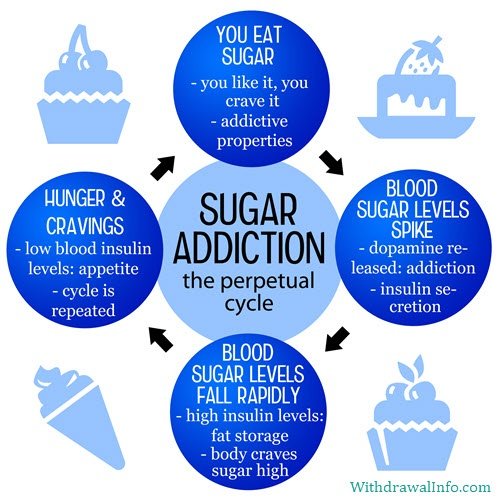Sugar Addiction
Sugar is everywhere. It is in the foods we eat and the drinks we consume on a regular basis. While sugar is not dangerous in moderation, most of us consume more sugar than we should. Over time, it can become difficult to cut back on sugar, leading some to believe they have a sugar addiction. Keep reading to learn about the addictive properties of sugar, withdrawal symptoms, and how to break a sugar addiction.
Can you be addicted to sugar?
People may feel like they are addicted to sugar, relying on foods and drinks that contain sugar to get through the day. These individuals are experiencing a habit instead of a real addiction. While it is easy to become reliant on sugar, it is not considered addictive like other substances. However, just because sugar is not traditionally “addictive,” it can still be a difficult habit to break. The signs and symptoms of a dependence on sugar can mimic the signs and symptoms of addiction.
Sugar Addiction Facts
It is almost impossible to avoid sugar. In moderation, sugar can be part of a healthy diet. However, issues arise when individuals consume more than the daily recommended value of sugar. A little bit of sugar in your diet is not likely to do much harm, but 75% of Americans consume sugar in excess.
A sugar addiction may not be recognized as a medical condition, but it can still impact the way people live. An addiction to sugar more closely resembles a bad habit that is difficult to break. A person may enjoy the effects of consuming sugar and have a difficult time replacing the bad habit with a good one. Diet and lifestyle changes are not easy feats, and a reliance on sugar can persist despite negative consequences.

How addictive is sugar?
Sugar can impact the reward center of the brain, activating opiate receptors. Eating sweets and consuming sugar reinforces neuropathways and trains the brain to crave sugar. Over time, more sugar is required to achieve the same effects and an individual can develop a tolerance to the substance.
How addictive is sugar compared to other drugs?
The effects of sugar on the brain have been compared to the effects of cocaine. One study involving rats found that a dependency on sugar mimics many aspects of addiction, including cravings, binging, and withdrawal. However, while sugar has addictive properties, it is not considered more addictive or dangerous than illegal drugs, opioids, and other substances at a high risk of addiction.
Why is sugar so addictive?
Consuming sugar is like giving your brain a reward. By activating the opiate receptors in the brain, consuming sugar reinforces a rewarding behavior. When you consume sugar, dopamine is released and you can experience a “high.” The feeling is pleasurable, so individuals try to recreate it. This cycle can lead to cravings for sugar, making it difficult to cut back or stop consuming sugar altogether.
Sugar provides the body with a quick hit of energy. Many people consume sugar in the afternoon, eating a candy bar or drinking a soda for a burst of fuel to make it through a long workday. Soon after the initial effects of sugar hit the body, the pancreas produces insulin and blood sugar levels can drop. This change can cause people to feel tired and suddenly wiped out, which leads to a search for more sugar.

Sugar is also readily available and in many of the foods and drinks we consume on a regular basis. Some individuals may have a sweet tooth, craving baked goods or candy. However, people who prefer to reach for chips, fries, and other starchy foods experience the same spike and crash in their blood sugar level.
The more times a behavior is repeated, the harder it is to break a habit. As an individual consumes sugar on a regular basis, the brain adjusts to the release of dopamine. More sugar is required to feel the same pleasurable high as before. Individuals may start consuming sugar more frequently or in higher amounts to achieve the same rewarding feelings. This pattern results in substance misuse.
Sugar Addiction Symptoms
Sugar addiction may be easier to recognize than addictions to certain drugs or substances. The outward signs of sugar addiction are relatively simple to spot, though some people may try to hide their reliance on sugar for a while. If the brain has been rewired to crave sugar, an individual may experience the following symptoms.
- Recognition of a problem related to sugar addiction and attempts to hide it
- More sugar is required to satisfy cravings
- Consuming sugar whether an induvial is hungry or not
- Consistent cravings for sugar, sweets, or salty foods
- Attempts to quit or cut back on sugar consumption without success
- Consuming sugar to soothe or cope
- Consuming sugar despite negative consequences, including health problems
- Going to great lengths to get sugar
- Feelings of guilt over consuming sugar
Individuals who consume more sugar than is recommended can also experience adverse health effects. Consuming too much sugar can lead to weight gain, higher risk of diabetes and heart disease, fatigue, cavities, and acne.
Sugar Addiction Withdrawal Symptoms
Over time, the body and brain adjust to the presence of sugar. If you find yourself consuming too much sugar or struggling to control your sugar consumption, it can be difficult to cut back due to uncomfortable withdrawal symptoms. The effects of sugar are similar to addictive drugs, including physiological and behavioral side effects. When someone is deprived of sugar, they can experience a range of withdrawal symptoms.
Sugar addiction withdrawal symptoms can occur when someone initially cuts sugar out of their diet or significantly reduces the amount of sugar they consume. Symptoms can last for a few days or a few weeks. Common symptoms of sugar withdrawal include:
- Cravings for sugar, sweets, and salty foods
- Headaches
- Fatigue
- Aching muscles
- Nausea
- Bloating
- Stomach cramps
- Irritability
- Anxiety
- Depression
- Mood swings
How to Break a Sugar Addiction
When it comes to breaking a sugar addiction, there are safe ways to cut sugar out of your diet. Instead of reaching for foods and drinks that contain added sugar, it is best to replace these items with fruits and vegetables. Vitamins, fiber, and naturally occurring sugar are found in fruits and vegetables, which can help manage sugar cravings while providing valuable nutrients.
You can also manage sugar cravings by adding more protein into your diet. Both animal and plant-based protein sources can help you feel more full and regular your appetite. Try satisfying your sweet tooth with fresh fruit because naturally occurring sugar is better than added sugar in candy bars or baked goods.
If you are trying to break a sugar addiction, it is important to get enough sleep at night. Fatigue can make cravings for sugar more intense and harder to ignore. Try to relax as much as possible when cutting sugar out of your diet because stressful situations can trigger sugar cravings.
How long does it take to break a sugar addiction?
Cravings for sugar and sugar addiction withdrawal symptoms can last a few days or weeks. Each individual’s experience is different, based on a variety of factors. The first two to three days without sugar are typically the hardest. However, within a few days, most people will have diminished cravings for sugar.
Sugar Addiction Treatment
Those struggling with sugar addiction should reach out to their doctor for help. A doctor can recommend a healthy diet and exercise routine to combat the effects of sugar addiction. They can also provide personalized recommendations to help replace sugary foods and drinks with healthier options. A doctor may also be needed to help deal with the side effects of sugar addiction, including weight gain, mental health issues, and other health consequences.

Sugar Addiction Detox
Some individuals find it easier to cut sugar out altogether, while others attempt to wean themselves off of sugar. If going cold turkey does not produce successful results, it may be easier to slowly taper off your sugar consumption. Try to replace sugary drinks or soda with water or sugar-free alternatives. Replace candy or baked goods with healthier alternatives with fruits, vegetables, and protein. Small steps taken each day can help mitigate the effects of sugar withdrawal and make the process sustainable.
Sugar Addiction Help
If you are struggling to cut back on your sugar intake, consider the following tips.
- Try to combine sugary foods with healthy foods, such as bananas and chocolate
- Chew gum to combat sugar cravings
- Keep fresh fruit on hand
- Exercise or move to get your mind off of sugar cravings
- Eat on a regular schedule to stay satisfied throughout the day
It is always best to seek a doctor’s help if you are dealing with an eating disorder or having trouble curbing your sugar intake. A doctor can evaluate your overall health and make appropriate recommendations to ensure your physical and mental wellbeing are secure.
Sugar Withdrawal
There are a wide range of reasons people may reduce their sugar intake or cut added sugar out of their diet. From regulating weight and managing health issues to developing a healthier diet or lifestyle, removing added sugar from a diet can have a wide range of benefits. However, it is not easy to cut back on the amount of sugar consumed. Over time, individuals can develop a reliance on sugar and cravings make it harder to remove sugar from their diet.
Withdrawal symptoms can occur when someone quits sugar cold turkey or significantly reduces their sugar intake. These symptoms are not life-threatening or dangerous, but they can be uncomfortable. Individuals may be tempted to relapse and consume sugar again in order to stop the withdrawal symptoms. Keep reading to learn more about sugar withdrawal, including tips to combat withdrawal symptoms.
Can you have withdrawals from sugar?
You can experience withdrawal symptoms if you reduce your sugar intake or cut out added sugars altogether. Long-term exposure to sugar in high quantities can change the brain, just like other addictive substances. Consuming sugar can activate the reward center in the brain, which reinforces the behavior. After consuming high quantities of sugar for a long period of time, it can be difficult to combat cravings.
What does sugar withdrawal feel like?
Sugar withdrawal is unpleasant but not dangerous. An individual may feel out of sorts when they cut sugar out of the diet as their brain and body adjust to the changes. Continuous sugar consumption can impact how much dopamine is released naturally by the brain. When sugar is removed from a diet, the brain has to readjust.
If someone has had a sugar habit for an extended period of time, they will have to adjust to a new normal. They are likely used to the burst of energy or pleasurable sensation that comes from consuming sugar. Their normal routines and habits are also interrupted. An afternoon candy bar or sweet snack may be second nature, and it can be uncomfortable to adjust to a new routine.
Sugar Withdrawal Symptoms
Symptoms of sugar withdrawal are typically mild, but they are still unpleasant. Sugar withdrawal symptoms can impact a person’s physical, mental, and emotional health. It may be difficult to push past withdrawal symptoms because consuming sugar will make the symptoms subside.
Common symptoms of sugar withdrawal include:
- Cravings for sugar, sweet foods, or salty foods
- Fatigue or lack of energy
- Muscle aches
- Headaches
- Nausea
- Bloating
- Cramping in the stomach
- Anxiety
- Irritability
- Mood changes
- Depression
Signs of Sugar Withdrawal
Sugar withdrawal may be apparent in a person’s mood and actions. Fatigue and weakness are two of the most common signs of sugar withdrawal. A person may feel muscular weakness across their whole body as it responds to a decrease in sugar consumption. While fatigue and weakness are uncomfortable, they are not alarming.
Extreme cravings are another sign of sugar withdrawal. Cutting sugar out of a diet can cause very intense cravings for sweets throughout the day. Individuals may be tempted to reach for a soda, candy, or baked good to satisfy a sugar craving.
When someone reduces their overall caloric intake, they might experience confusion. Confusion is a possible sign of sugar withdrawal because there is less glucose in the body. Individuals may feel off or not completely like themselves for a while as they go through sugar withdrawal. Unfortunately, confusion may be part of the process when it comes to changing a habit or lifestyle.
Sugar Withdrawal & Headaches

There are many reasons an individual might experience a headache, including sugar withdrawal. Consuming sugar in high quantities or on a frequent basis can impact the body’s nervous system.
When sugar is removed from the diet or significantly reduced, headaches may occur as the body adjusts. The nervous system must change, and a headache can linger for multiple days during the process.
Sugar Withdrawal Headache Relief
Headaches are uncomfortable, and they can make sugar withdrawal more difficult. If you experience headaches after cutting back on sugar, there are several ways to find relief. Drink plenty of water to prevent dehydration, which can make existing headaches worse. Practice regular exercise or movement to release endorphins and naturally regulate blood sugar levels. Add protein to your diet to reduce sugar cravings and stay full, which can help reduce headaches. If headaches persist, talk to your doctor about additional solutions.
Sugar Withdrawal & Diarrhea

Sugar withdrawal can impact a person’s digestive system. Blood sugar levels drop when sugar is removed from the diet, and the body may secrete excess insulin as a result.
Discomfort is likely to occur in these situation, including diarrhea and stomach cramps. Individuals may also experience nausea, constipation, bloating, and stomach discomfort when they reduce their sugar intake.
Sugar Withdrawal & Insomnia

Poor sleep quality is a common side effect of sugar withdrawal. As the body adjusts to a decreased amount of sugar, certain hormones are decreased in the process. The brain is forced to work in different ways throughout sugar withdrawal, which can impact a person’s sleep quality.
An individual who cuts sugar out of their diet or greatly reduces their sugar intake may experience difficulties when sleeping, including insomnia. This symptom is not likely to persist for more than a week. If it does continue, it is important to speak to a physician.
Sugar Withdrawal Timeline
Sugar withdrawal occurs in stages, and the exact timeline of withdrawal can differ by individual. At first, a person may start out with a high level of motivation to reduce their sugar intake. They might be encouraged by a doctor, friend, or family member to adjust their lifestyle and adopt a healthier diet. Health issues or other consequences of sugar addiction could spur them to make changes.
Next, sugar cravings are likely to occur as someone changes their diet. They may experience intense cravings for sugar for multiple days. Cravings will vary in intensity by person and situation. During this time, it is important to find healthy alternatives to sugar and substitutes for a well-rounded diet.
Headaches may occur next and last for multiple days followed by other aches and pains. An individual can experience mood changes, tremors, and chills. When symptoms of sugar withdrawal peak, a person can also suffer from depression or anxiety as their lifestyle changes. It may be difficult to stay motivated during this time due to strong cravings and uncomfortable withdrawal symptoms.
Finally, symptoms begin to resolve within a couple of weeks. Cravings for sugar may occur from time to time, but they can be easier to manage. Hopefully by this point, an individual has implemented healthy habits and lifestyle changes to combat sugar cravings and keep a sugar addiction at bay.
How long does sugar withdrawal last?
Sugar withdrawal symptoms can last for days or weeks. There is not exact timeline for sugar withdrawal, and each individual will have a different experience. The first week of sugar withdrawal is likely to be the hardest, with cravings at their most intense. After another week or two, symptoms will subside and become less intense.
If sugar withdrawal symptoms last past a few weeks, it is important to speak to a doctor. A physician can help someone supplement their diet in healthy ways to maintain a consistent energy level or sleep schedule.
Tips for Sugar Withdrawal Relief
The unpleasant symptoms of sugar withdrawal can lead people to reach for sugar again. Consider the following tips to mitigate the effects of sugar withdrawal and break a sugar habit.
- Work with your doctor to develop a healthy diet and exercise plan
- Get active to combat sugar cravings
- Switch to non-food rewards for positive reinforcement
- Stock your kitchen with healthy foods that are naturally sweet, like fruits
- Drink plenty of water throughout the day to keep cravings at bay
- Remember the many health benefits of reducing your sugar intake to stay motivated
- Find an accountability buddy to help encourage and motivate you
- Keep an eye out for hidden sources of sugar to avoid developing a new habit
- Take up a new hobby or do something you love to take your mind off of sugar cravings
- Meet with a counselor to address triggers for sugar cravings and potential eating disorders
- Be patient with yourself throughout the process as you learn new habits